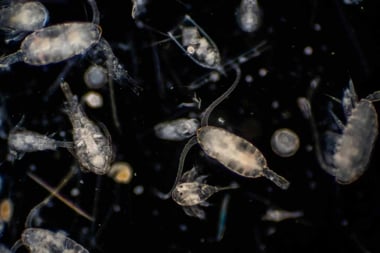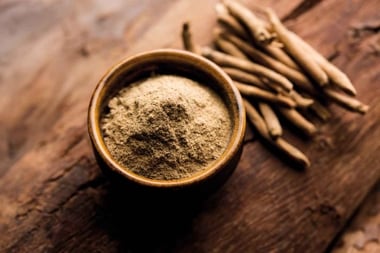
You may not think of herbs when you start to cough or sniffle, but herbs can be effective combatants in the prevention and treatment of colds and flu.
The doctor tells his flu patient to take two acetylsalicylic acid tablets and call him in the morning. “Do you mean aspirin?” asks the patient. “That’s it,” replies the doctor, “I can never remember that word.”
This joke pokes fun at the propensity of professionals to gild their lilies of advice with a complicated vocabulary. “For every complex problem,” wrote H.L. Mencken, “there is an answer that is clear, simple, and wrong.” For example, taking aspirin to relieve flu symptoms.
We are all familiar with common cold and flu preventives and remedies, such as adequate sleep, low stress, and sufficient amounts of vitamins C and D. If we still fall victim to the bug there are those noble soldiers, echinacea; astragalus; ginger; medicinal mushrooms (reishi, maitake, and shiitake); goldenseal (especially effective for sinus infections); and chicken soup.
But the herbal compendium is rich with lesser known herbs that will have you back on your feet in this freezing, sneezing season, or better yet, will shield you from the viruses in the first place.
Yarrow Willard, a clinical herbalist in Cumberland, BC, emphasizes the synergistic properties of herbs. He analogizes herbs to a warrior tribe fighting to protect the village, which of course, is your body. Yarrow recommends the following herbs.
Common cold combatants
Usnea
Found worldwide, usnea is the generic and scientific name for several species of grey or greenish hairlike lichen that grow on tree branches. Sometimes referred to as old man’s beard, beard lichen, or treemoss, it has been used medicinally for at least 1,000 years. Usnea is used to treat lung, upper respiratory tract, and urinary tract infections.
Osha (Ligusticum porteri)
This First Nations favourite is considered a warming herb, primarily for the respiratory system. Because of its strong antiviral properties, it should be taken at the first sign of flu or cold. It is very effective for sore throats and bronchial inflammation and will soothe and anaesthetize almost immediately. With its diaphoretic properties, osha causes sweating and helps to eliminate toxins.
Note: do not use osha during pregnancy or if breastfeeding.
Lomatium root (Lomatium dissectum)
Native to western North America, this is now a threatened species and should not be wildcrafted. It was used by the First Nations people as their most powerful antibiotic and antiviral herb. Lomatium is also known for boosting the immune system and reducing inflammation.
Marsh mallow (Althaea officinalis)
Useful whenever a soothing effect is needed, the herb’s demulcent (soothing) qualities bring relief to dry coughs, bronchial asthma and congestion, and pleurisy.
Virus fighters and herbs for prevention
Andrographis (Andrographis paniculata)
This herbal medicine is derived from a shrub grown in moist, shady areas of India, China, and throughout Southeast Asia, and is commonly referred to as Indian echinacea. This popular Ayurvedic and Chinese preventive is also a remedy for the common cold, upper respiratory tract infections, flu, and other ailments characterized by fever.
Eleuthero (Eleutherococcus senticosus)
Also known as Siberian ginseng, this herb stimulates cellular immunity and provokes T-cell production.
Codonopsis (Codonopsis pilosula)
The roots are used in Chinese medicine to lower blood pressure, increase red and white blood cell counts, cure appetite loss, strengthen the immune system, and replenish chi. It is also used as a gentler and more economical substitute for ginseng.
Schisandra (Schisandra chinensis)
This woody vine with clusters of red berries is found in northern China and adjacent regions in Russia and Korea. As an antioxidant it enhances the immune system and promotes longevity. As an astringent it improves lung function. Schisandra also helps with hay fever, common cold, sore throat, and coughs.
Note: schisandra should not be used by pregnant women.
Elderberry (Sambucus nigra)
Its juice is a powerful antiviral, especially effective as a flu preventive. It can also be used to treat fever, upper respiratory tract infections, bronchitis, and coughs.
Decongestants and cough remedies
Peppermint (Mentha x piperita)
Its main active agent, menthol, is an effective decongestant. Menthol also thins mucus and therefore works as a good expectorant, helping to loosen coughs with phlegm. It is also soothing and calming for sore throats and dry coughs.
Hyssop (Hyssopus officinalis)
The antispasmodic properties in hyssop can bring relief from spasmodic coughs.
Horehound (Marrubium vulgare)
This effective immune booster contains vitamins A, B, C, and E; essential fatty acids; iron; potassium; and marrubin (an expectorant). Horehound has proven to be effective in loosening phlegm and mucus in the bronchial tubes and in the lungs. It also relieves coughs and sore throats.
Holy basil (Ocimum sanctum)
Also known as tulsi, it is an essential ingredient in many Ayurvedic cough syrups. It helps mobilize mucus in bronchitis and asthma.
Mullein (Verbascum thapsus)
This is a valuable herb for coughs and congestion and a specific treatment for tracheitis (inflammation of the trachea) and bronchitis. It’s a common herb among First Nations people.
Elecampane (Inula helenium)
This herb was prized by the Romans as a medicine and a food. Useful as a tonic and a warming herb for the respiratory system, it effectively and gently clears mucus from the chest.
Fever relief
Boneset (Eupatorium perfoliatum)
This First Nations remedy for colds and fever was adopted by early settlers to North America. The name refers to the plant’s use in treating dengue or breakbone fever, a viral infection that causes such intense muscle pain that sufferers fear their bones will break. The polysaccharides in boneset also activate T-cells to fight bacterial infections.
Yarrow (Achillea millefolium)
This antiviral and antibacterial contains salicylic acid, the active ingredient in aspirin. To reduce fever, yarrow combines well with elderflower, peppermint, boneset, cayenne, and ginger.
Most herbalists recommend tinctures for their efficiency and speed of absorption, but herbal teas can also be healing and soothing.
We need to guard against viruses and flu bugs as surely as we need protection from reckless drivers and identity thieves. This winter, check with your local herbalist or natural health store to get these gallant combatants on your side.




